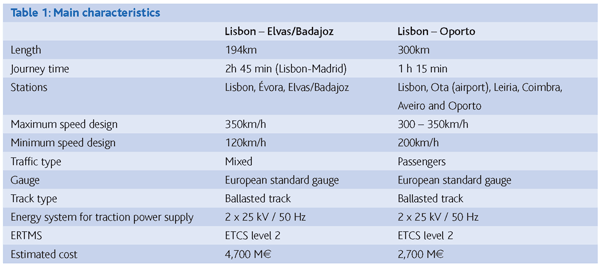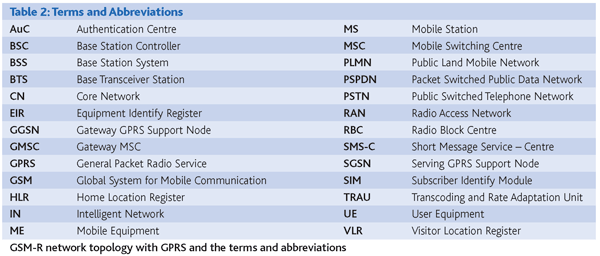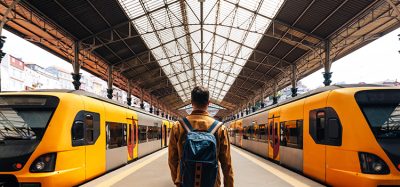High-speed and GSM-R: Portuguese overview
Posted: 28 July 2006 | | No comments yet
By decision of the Portuguese Government, a High Speed Transportation System shall be developed which offers both international high-speed and national high-speed train services (passenger and freight) accommodating the increasing requirements for cross-border mobility and which contributes to the strengthening of the economic position and social cohesion, in particular between neighbouring regions of Portugal and Spain.
By decision of the Portuguese Government, a High Speed Transportation System shall be developed which offers both international high-speed and national high-speed train services (passenger and freight) accommodating the increasing requirements for cross-border mobility and which contributes to the strengthening of the economic position and social cohesion, in particular between neighbouring regions of Portugal and Spain.
By decision of the Portuguese Government, a High Speed Transportation System shall be developed which offers both international high-speed and national high-speed train services (passenger and freight) accommodating the increasing requirements for cross-border mobility and which contributes to the strengthening of the economic position and social cohesion, in particular between neighbouring regions of Portugal and Spain.
The main objectives of the High Speed Transportation System, decided by the Portuguese Government, are:
- To strengthen links between Portugal and Spain, especially between neighbouring regions of the countries, and to contribute to the harmonious development of the EU, from the point of view of strengthening its economic and social cohesion
- To ensure the interoperability of European rail networks
- To strengthen the structure of the Atlantic Axis (defined as the corridor on the Iberian Peninsula alongside the Atlantic Ocean, comprising all major Portuguese cities and the major cities in Galicia in Spain), and related internal and external links with Europe, and in particular, with Spain, in connection with one of the most significant areas of national development
- To facilitate mobility, providing new opportunities for attracting investment
- To improve the sustainability of the transport system by offering a competitive, high quality rail network in relation to the alternatives provided by air and road systems and with reduced impacts in terms of energy consumption and atmospheric pollution
- To promote intermodality through increased and improved connections with other transport systems, especially with airports.
At the Iberian Summit at Figueira da Foz held in November 2003, Spain and Portugal reached an agreement concerning the implementation of the high-speed rail connections between the two countries. The following links were considered:
- Oporto-Vigo
- Aveiro-Salamanca
- Lisbon-Madrid
- Évora-Faro-Huelva
Besides these international links, the network will be formed with a new line connecting Lisbon and Oporto, the two main cities of Portugal, which will be the future backbone of the Portuguese high-speed rail network.
At a recent Summit in Évora in November 2005, it was decided that the connection Lisbon-Madrid should support mixed traffic (passengers and goods), maintaining an overall journey time of approximately 2 hours and 45 minutes.
At the same summit, the interest of Portugal and Spain for the materialisation of the connections Porto-Vigo, Aveiro-Salamanca and Évora-Faro-Huelva was reaffirmed. The dates foreseen for their conclusion will only be secured after the current studies are finished to decide the feasibility conditions.
Considering the National priorities, the Portuguese Government decided to implement the following plan:
- Lisbon-Madrid Line to be completed by 2013
- Lisbon-Oporto Line to be finished by 2015
The strategic plan for the Portuguese Railways includes two more crucial actions that will optimise the operation, the effectiveness and profitability of the rail system:
- The integration of the conventional and high-speed lines that deal with issues such as the interoperability and the migration of the gauge from the existing lines to the European standard gauge
- To guarantee the articulation with the Logistic National System, as well as with the ports, airports and road systems, contributing to the significant increment of the volume and global value of the goods to transport by the railways, to potentiate the privileged geo-strategic positioning of Portugal to assume as the entrance door in the European space for the products of the transcontinental routes of Atlantic Ocean
The main characteristics of these two lines are shown in Table 1.
The High Speed Railway System shall be designed, constructed, commissioned and maintained in accordance with Council Directive 96/48/EC, modified by Directive 2004/50/EC.
Additionally, the High Speed Transportation System shall be cost efficient with regard to:
- Investment costs
- Maintenance costs
- Operational costs
The deployment of the GSM-R Network
Following the general description of the future Portuguese high-speed network, this next section will describe the mobile communications network and the technical and functional requirements appropriate to the exploitation of the highspeed lines (HSL).
History
Railways are major users of mobile radio systems. They use radio for a wide range of services, such as train radio communications, operation and maintenance, shunting, passenger information, etc. In Europe, most of the old systems were based on analogue technology, according the UIC 751-3 leaflet. However, the systems of several countries were not interoperable between each other. Those systems have now exceeded their product life cycle and the railway administrations face the following questions:
- What technological solution will support the needs for interoperability enabling the border crossing with the same radio equipment?
- Which digital technology will be the best to replace the aging analogue systems, and guarantee future evolution of a new system?
The UIC started to investigate the introduction of a European mobile railways communication system 19 years ago. The identification of features for mobile railways communication and their characteristics was an ongoing task for several years, due to the differences in railways operation in the different countries.
The UIC anticipated the need for a common wireless data frequency band and digital communications standard for border-crossing rail traffic, and so conducted a detailed technical and economical survey of digital technologies and, in 1993, decided to base the new system on GSM (Global System for Mobile Communications). This would ensure that railways could participate in the evolution of the public standard to include their specific needs. In addition, they might benefit from the economy of scale of the existing public market for the cost of their equipment.
The decision to choose an open standard had some drawbacks, as not all specific requirements were covered by the GSM. Enhancements for special needs were necessary, which were researched and defined by the UIC’s ‘European Integrated Radio Enhanced Network’ (EIRENE) Project. The GSM system had to be modified to meet several types of features and requirements specific to railways, namely:
- Fast and guaranteed call set-up, (over all on emergency calls – maximum two seconds)
- Enable seamless communication for train speeds of up to 500km/h
- Functional addressing (e.g. a train number or coach number) for setting up a call and for display of calling/called party
- Location dependent functions, e.g. connection to the local ground
- Broadcast and group calls
- Priority and pre-emption mechanisms
- Set-up of urgent or frequent calls through a single keystroke or similar, including emergency call
- Train control European Rail Traffic Management System (ERTMS)
- Link assurance, an indication that the connection is maintained
- Automatic mobile network management
- Control over system configuration
- Automatic and manual test modes with fault indications
- Increased flexibility of operation through the use of SIM cards
In 1995, the UIC decided to establish a project to set up tests of the new system. Three railways, SNCF, DB, and Firenze SMN (Italy), set up the consortium ‘Mobile Radio for Railway Networks in Europe’ (MORANE) to conduct the trials. The overall aim of the project was to specify, develop, test, and validate the new GSM-R (GSM for Railways) system.
As a result of studies within the UIC and of discussions with CEPT, co-ordinating the management of radio frequencies in Europe, the 900 band was shown to be most suitable for several reasons such as favourable radio propagation conditions and ease of applying GSM technologies. In 1995, 876–880 MHz was assigned as the uplink band and 921–925 MHz as the downlink band, which gives 19 channels. (In Portugal, approximately half of that spectrum is still occupied for military purposes. RAVE and REFER are aiming to obtain at short term, the liberation of the entire band).
The EIRENE project had already identified some basic telecommunication features, which they passed on to the European Telecommunications Standard Institute (ETSI) for standardisation. The project was successfully finalised in 2000 with the approval of the new system by the railways.
Nowadays, GSM is by far the most successful system for public mobile cellular networks. The new GSM-R platform will replace the various, mutually incompatible, national railways radio networks, which are based on analogue transmission techniques. In several countries outside of Europe, railways are also preparing the introduction of GSM-R. A Memorandum of Understanding (MoU) has been signed in most European countries and implementation is progressing well.
Framing
The design of the Control-command and Signalling System shall comply with the requirements described in the technical specification for interoperability relating to the control-command and signalling subsystem of the trans-European high-speed rail system (Directive 2002/731/EC: TSI Control-command and Signalling of 30 May 2002).
The subsystem is a traffic control system, which supports reliable train operations, and guarantees safe train operations. It consists of:
- Central Traffic Control, excluding building (Office furniture and equipment and CTC equipment)
- Signalling systems (ERTMS, interlockings, trackside equipment and technical buildings and housings)
- GSM-R communication system
The GSM-R communication system shall comply to the latest international approved versions of the TSI’s, UNISIG SRS’s (V2.2.2), EIRENE specifications (FRS V7.0 and SRS V15.0), ERTMS QoS Test Specification (O-2475 v1.0), GSM-R Interfaces Class1 Requirements (Subset 093), Agreed change requests on V2.2.2 (Subset 108), and other European railways standards, (EN 50126, 50128, 50129, and 50125-1) and other National Standards.
Main goals
For High Speed Operations it will be necessary to provide a set of requirements, such as the following:
- Fulfilment of international European standards and totally interoperable and seamless border crossing
- Railway specific services
- Integration of all railway services into one communication network
- High reliability and availability
- High transmission quality for high speed mobiles supporting ETCS level 2 transmission;
- Cost effectiveness and economy in realisation and operation
- Reduced maintenance and service cost
- Open for technical evolution (state-of-the-art technology) and ability to smoothly integrate new services which will be defined in future
In the field of voice communication, besides the basic and supplementary services already included on standard GSM phase 2+, are required the following features:
- ASCI (Advanced Speech Call Items) features to facilitate group and multi-address calling, i.e. distribution of information amongst a number of pre-defined GSM-R subscribers
- Prioritisation and priority override of calls depending on the subscriber’s authorised priority, (eMLPP – enhanced multilevel precedence and pre-emption)
- Functional addressing, that allows a user or application to be reached by means of a number that identifies the function and not the physical terminal (e.g. train number)
- Presentation of Functional Number that allow visual presentation of the destination and originating call
- Location-based addressing, allows the caller to reach a “duty subscriber” or “function” using the same number, depending on the radio cell in which he is located
- Access matrix, validate access capability for communications among users and groups of users, (e.g. only the dispatcher can call the train driver as a mobile subscriber. For other subscribers it is prohibited to call the functional numbers of trains)
Concerning data transmission applications, the following applications must be provided:
- ETCS (automatic train control)
- Rolling stock telemetry (train diagnostic, alarms, maintenance)
- Fixed installations telemetry, (e.g. meteorological stations, viaducts, bridges and tunnels monitoring systems, where the connection to the fixed network is not economic advantageous)
- Train positioning
- Image transmission such as CCTV imagery in stations or from carriages
- Staff communications, like access to operational data bases, scheduling, tariffs information, intranet and e-mail
- Electronic ticketing and payment
- Seat reservation
- Passenger information systems on trains, real time journey information, car rental, taxi ordering, hotel reservations, etc.
- Logistics, i.e. tracing cargo coaches, containers, goods, polling of status information on goods
- Optimised freight load and on-line sale of free transport capacity
Conceptual design
To achieve all the requirements and features, it will be necessary to define the system requirements for the base station, switching and network management sub-systems.
In terms of capacity one MSC will be enough for our National Rail Network, (conventional and HS lines), considering the train traffic and the total number of railway users, but we will use two, for ensure service if one fails. For availability reasons, it is necessary to implement a redundancy concept for the main elements of the core network, the MSC/VLR and HLR/AuC. The redundancy issue can be addressed with two different concepts:
- Relaying on the integrated redundancy of the network elements
- Duplicate elements and geographical redundancy
The availability level desired for the network and the redundant solutions to be used will depend strongly of the ETCS solution to be implemented on the HSL. We are considering two scenarios:
- ETCS level 2 with ETCS level 1 as fall back system. In this case the solution can be: integrated redundancy of all equipments and geographical redundancy for the core equipment (disaster recovery concept)
- ETCS level 2 without fall back system. The solution will be a totally redundant network, with integrated redundancy of all equipments, geographic redundancy for the core and double radio coverage. (The “double coverage”, means that the base station planning is done in such way that any point along the track is covered by two independent BTS)
At the level of the fixed transmission network, it is crucial do implement a highly available network, based in SDH rings, supported on optical cables, installed on both sides of the tracks.
Equally the power supply systems shall be redundant, fed from two alternative sources of energy, (energy from public sector, with redundancy from the catenary system).
An Intelligent Network (IN) can be added to provide functions defined in EIRENE and enhance non-standardised functions, such as:
- FFN (Follow Me Functional Node)
- Location-dependent addressing
- Additional administration and authorisation functions such as the Access Matrix
- Functional addressing for SMS
- Group communication support
- Functional numbers with variable length
- Support of dedicated location processing systems
The ever increasing demand for data transmission, in terms of type of services and bandwidth, constitute a driving force pushing towards implementation of GPRS (or EDGE) in the GSM-R networks. Another reason to that is the rapidly depleted of radio resources, when many sources transmit small data packages simultaneously in a given sector or cell.
Therefore, GPRS with channel bundling, high data rates, fast channel acquisition and release, time slot sharing, and ‘connectionless’ transmission, can offer a flexible, realistic and economically viable solution to the implementation of the data applications mentioned above.
Related to the implementation of the GPRS, the following questions must be decided:
- Use dedicated or flexible allocation of GSM/GPRS channels?
- Which data must be carried via circuit switched or via GPRS?
- And what fail safe measures will be needed?
The management, operation and maintenance of this network will be provided through a Network Management and Operations & Maintenance sub-system. These activities can be divided according to their different goals:
- Maintenance – activities for re-establishing the service (after a fault), or keeping the system working properly
- Operations – activities related to introduction of new services or change configurations
- Administration of subscribers – management of user’s data and profiles, billing, listing of data for statistics, etc
- Security functions – Checking the licence of the participant in the Authentication Centre (AuC), encoding of subscriber’s data, checking the sets in the EIR, etc
Co-ordination between EIRENE networks and roaming agreements
To achieve true interoperability, it will be necessary to co-operate with our neighbouring railways in several important aspects, like radio planning for allocation of frequencies at borders, establishing roaming agreements and dealing with question of national features.
Roaming agreements between the EIRENE networks have to be established to provide seamless cross-border operation of international trains, and mobility for the authorised railway users. To ensure interoperability for train drivers and other users roaming between networks, it is important to harmonise subscription details and other information stored in the network and agreed on essential aspects like billing, tariffing and network management.
Although the GSM-R network guarantee the coverage of the complete HSL, RAVE wish to establish appropriate roaming agreements with the public network providers so that users of a mobile GSM-R terminal can use it outside the HSL area enabling total mobility. Additionally roaming can be considered to situations where blocking or faults in the GSM-R network occurs.
Coverage of the HSL by public mobile operators
In view of assuring the possibility of the passengers of the high-speed service, RAVE intend to establish agreements with all the mobile public operators to provide the coverage of the HSL.
For that purpose, RAVE is available to create the conditions for the installation of sites, towers, energy and transmission to be shared by all operators, reducing strongly the investment costs and the environment impact.
Considering that high-speed trains actuate like a screening effect for the mobiles inside the carriages, the level of the radio signal is strongly attenuated, and the train operator can decide to install repeaters on board to allow a good transmission quality. Additionally, there will be a study into the feasibility of establishing wireless onboard internet.











